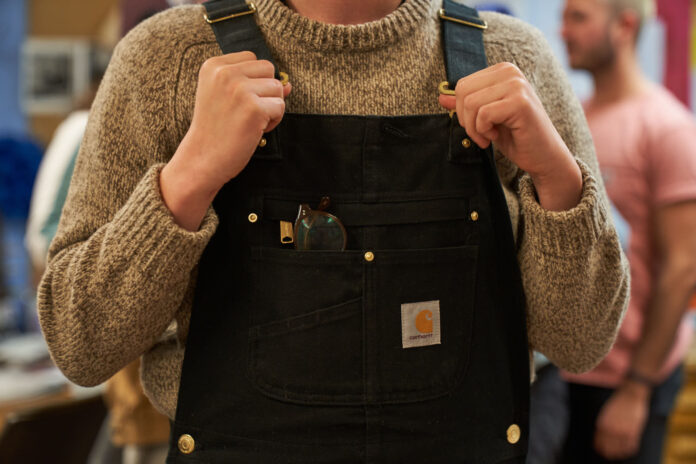The rise of Carhartt
A rite of passage for any young person living in a metropolitan area is the tragic yet universal act of getting crushed by someone they fancy in a Carhartt beanie. Often in a hue resembling an orange traffic cone, these Carhartt beanies have come to represent a new archetype of city-dweller: one who is deeply aware of trends with an interest in fashion and alternative culture. The same can be said of crusty skaters, who regularly don carpenter pants while shredding the gnar. Even baristas in third-wave cafes, with oat milk lattes sitting on blondewood counters, pour French roast while wearing Carhartt-emboldened smocks. The question is: When did a workwear company founded in 1889 become the de-facto uniform of those looking to be on the cultural radar? And how exactly did this happen?
To understand the phenomenon of Carhartt’s rise to cultural prominence, we must first understand its humble beginnings. In 1889, Hamilton Carharrt opened a small workshop in Dearborn, Michigan. With two beat-up sewing machines and five spritely workers, the company began creating canvas jackets and bibs. By World War II, Carhartt had become a household name, with workshops in the United Kingdom and Canada popping up as well. Throughout the 20th century, it became the go-to choice for many blue-collar workers throughout myriad industries, including manufacturing, agriculture and forestry. Carhartt has come to symbolize someone who works with their hands — someone who is more comfortable with a hatchet than a spreadsheet.
Perhaps this has been a factor in its rise to cultural relevance. In the modern age, the search for authenticity has yielded slim pickings. With more and more aspects of daily existence bogged down by profit and solecism, it would make sense for a disillusioned generation of youth to latch on to a sense of truth by looking at something they don everyday: their clothes.
By co-opting a blue collar staple, many young people find meaning in their work, no matter how mundane or surreal. Speaking as someone who has dipped their toe into the job pool recently, one can understand the urge when positions at companies are labelled things like “Director of Culture” or “Chief Vibe Executive.”
Speaking in the charming drawl of his native Northern Ireland, Dan McCourt, a third-year political science and English double major, remarked that his Carhartt backpack made him want to “just simply till the fields.” After a good chuckle, he went on to say, “But no joke, this is the most reliable bag I’ve ever owned.”
Indeed, it is an indisputable fact that Carhartt simply makes good, functional products. There’s a reason co-opting is happening in the first place — products from the Michigan-based company were originally prized by those working in blue collar fields for their rugged and reliable nature. “Honest Value for an Honest Dollar” was Carhartt’s slogan when it was founded in the 19th century, and that sentiment still holds true today. In fact, the most affordable coat Carhartt makes is around $80 — not an insane price but not one to scoff at either. Their most expensive coat, on the other hand, maxes out at $230.
There’s nothing outlandish going on with their pricing, and there doesn’t need to be. Carhartt knows its core audience quite well and prices accordingly. This price point, one that holds a deep standard of quality, is just as attractive to people farming in Iowa as it is to students looking for a winter coat in Davis.
Indeed, when speaking of a coat they procured from Carhartt, Chloe Hammond, a fourth-year design major said, “It just gets the job done.” A student sitting next to Hammond remarked that the Carhartt beanie they had on was originally their father’s, who passed it on to them.
There is no doubt that students and other young folks make up an increasingly large percentage of the Carhartt brand. So much so, in fact, that an offshoot of the original company began in 1989, one hundred years after the start of the original. Dubbed Carhartt WIP (Work in Progress) by its founders Salomee and Edwin Faeh, the company was one of the first exporters of Carhartt to Europe. Eventually, they were granted a license to design under the WIP moniker and began to stylize their clothes towards a more streetwear oriented aesthetic, with lighter fabrics and more flattering silhouettes.
The WIP label capitalizes on the clout surrounding Carhartt, creating t-shirts and accessories that are a far cry from the original’s workwear roots. And it’s worked. WIP has been donned by many, most notably hip-hop artists and actors, to become a cultural mainstay. The prices inarguably reflect this shift from utility to trendsetting. The cheapest coat on WIP’s website is $128, discounted from the original $288. The most expensive one is $615.
On a recent trip to Berlin, I stumbled upon both a Carhartt supplier and a WIP store, while desperately searching for a family-owned film shop. (If that doesn’t tell you everything you need to know about their customer base, I can’t imagine what will.) I proceeded to spend an exuberant amount of Euros on various items in both places, including the most I’ve probably ever paid for a t-shirt. Yet, I loved everything I bought. Putting aside the durability, the ruggedness, the blue-collar influence and the co-opting of that influence for the sake of fashion, the garments I sought simply brought me joy. And when it comes to clothes, why wear it if it doesn’t make you happy?
Written by: Ilya Shrayber — arts@theaggie.org




